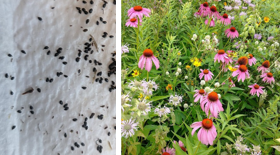It’s time to start native seeds for your pollinator garden!
There is so much magic and joy in starting wildflowers from seeds. This is a good time to start that process for many native plants so that they are ready in the spring. Many native plants' seed stays dormant until there are good conditions in the wild. As a gardener, you can create these conditions to break dormancy for seed germination. Many native seeds need cold moist stratification to germinate. This can be done outdoors if seed is planted in the fall and overwintered. If you want to start them indoors in containers then pre-treatment stratification is needed. Stratify by placing seeds in a damp paper towel, coffee filter, or sand and into a sealed plastic bag in the refrigerator (33-40 °F). Native plant's seeds range from needing 10 to 120 days of cold stratification. Once seeds have been stratified for the number of recommended days, plant seeds in a soil medium. Keep soil moist until seeds sprout and send up their first leaves. Water as needed and allow the soil to begin to dry out between watering. The magic continues as plants continue to grow!
Learn more about individual native plant seed pre-treatment and germination strategies in the Prairie Moon Nursery 2022 Cultural Guide and Germination Guide and the Tallgrass Prairie Center's Native Seed Production Manual.
If you aren't ready to start a new seed starting hobby, this is also a good time to start designing and planning a pollinator garden. Many local plant vendors have their plant catalogues ready for you to view. Be sure that plants you purchase are free of neonicotinoids, which are very toxic to pollinators.
See BWSR's Lawns to Legumes page for garden design templates and list of local native plant vendors.
When you subscribe to the blog, we will send you an e-mail when there are new updates on the site so you wouldn't miss them.
